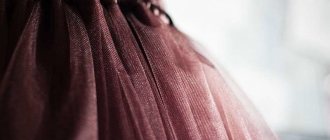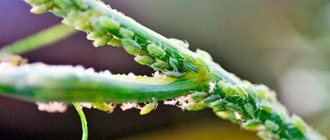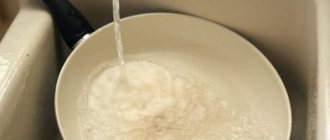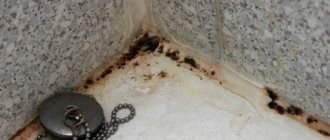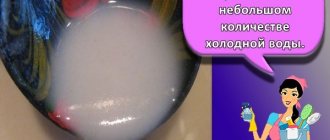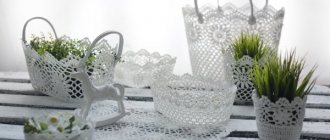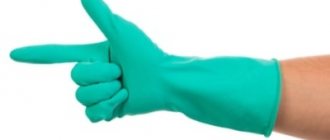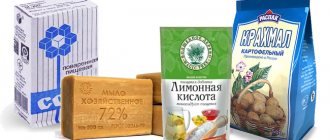What things are better not to starch?
When things are starched, a film forms on their surface, which provides a rigid shape, prevents curling of the edges, and evens out the pattern. There are many positive qualities, but there are still cases when using starch is not only useless, but also harmful:
- after processing, ugly whitish stains will most likely appear on dark things, so in this case it is better to look for another option;
- You should not starch things that should remain breathable, that is, allow air to pass freely, since the film formed afterwards is absolutely airtight;
- starching synthetic products is a pointless exercise, since the process has no effect on threads of such composition.
What you need to prepare for starching at home
Of course, you need to prepare the starch itself or another substance used for the starching process. But we'll talk about this a little lower.
Now let’s list the general things that you will need:
- pins made of stainless steel with heads;
- thin wire for inserting into the edges of the product for alignment;
- tape measure;
- spray bottle or bowl for solution;
- towel;
- flat surface (this can be a special board, carpet covered with film). It is desirable that the surface be covered with a checkered material; such a pattern can be used as an additional guide when laying out the product;
- if the product needs to be given some special shape, for example, if a cap is starched, then you need to prepare the appropriate blank. In its role, it is quite possible to use a jar or pan of the required size. Shuttlecocks can be dried on pencils, curlers or plastic bottles.
Basic means used for starching things
Starch
We take the amount of potato, corn or rice starch powder based on the required degree of rigidity of the knitted product. Dilute with a small amount of cold water and pour in a thin stream of boiling water while stirring continuously.
With hard starch, boiling for several minutes is possible if the paste is not transparent, but cloudy. Leave the item in the solution for a while, then wring it out. If the product is snow-white, for example a knitted collar, then it is better to take rice starch and dilute it with milk rather than water.
Sugar syrup
Pour 2 cups of sugar into a glass of water, stirring constantly, bring to a boil and the sugar is completely dissolved. We immerse the product in the syrup, soak it carefully and thoroughly, and squeeze it out. If after the procedure some places remain unevenly treated, then we additionally go through them with syrup using a brush.
If the required hardness is not achieved, the process must be repeated.
Straighten the wrung out product and pin it to a towel laid out on a flat surface. Dry thoroughly.
PVA glue
We dilute the glue with water in a ratio of 1:1 or 1:2, depending on the required degree of hardness. Fill a spray bottle with the solution, spray the product, or completely immerse it in the solution.
The method is excellent for starching voluminous headdresses, such as hats or crowns for children's parties.
Milk
Light items can be starched perfectly with skim milk. If necessary, you can add a small amount of starch powder to make a thicker solution.
Gelatin
A tablespoon of this dietary supplement is dissolved in half a glass of water and left until it swells. Then add up to a whole glass of water and heat the mixture until the gelatin is completely dissolved. Either a package of gelatin, a tablespoon of salt and half a glass of water are mixed in a half-liter container and brought to a steam bath until the substance is completely dissolved.
In both cases, the product is dipped into a gelatin solution after the mixture has cooled. Unlike starch, gelatin does not crumble and holds its shape perfectly until the next wash.
Gloss-starch
You can make it yourself, but there is also a ready-made drug sold in original packaging. In addition to the necessary rigidity, it gives the fabric a beautiful shine, so it is ideal for elegant items and tulle curtains.
All components are thoroughly mixed, the mixture is slightly diluted into a paste with cold water and applied to the laundry with a soft sponge. When the item is ironed, under the influence of the iron it acquires density and a beautiful shine.
Products that are used at home for manipulation
At home, it is common to use the following ingredients to prepare starch composition:
- Starch. A traditional product, which is first diluted with a small amount of cool water, then introduced into boiling water in a thin stream, stirring constantly. The result should be a transparent composition, which is cooled and used to soak the product. Next, the item needs to be slightly squeezed and given the desired shape, if necessary, securing the result with a hot iron. If you need to starch a snow-white collar, then it is better to take rice starch, and milk is more suitable for diluting it.
We recommend: Learning how to properly sterilize jars in the oven and in a pan of water
- Sugar. For two glasses of sugar, take a glass of water, mix the ingredients and prepare syrup from them over low heat. Soak the product in the resulting mixture, squeeze it out, and if necessary, treat dry areas with a brush. We spread the wrung-out item on a towel, straighten it with a crochet hook, and fasten it with pins, fixing the desired shape. After the product has dried, we evaluate the achieved degree of hardness and, if desired, repeat the procedure.
- PVA glue. We dilute the main ingredient with cold water once or twice, depending on the required hardness. We either immerse the item completely in the resulting composition (if you need to starch a snowflake, a removable knitted collar, or a napkin), or spray it with a spray bottle. This approach is most often used for processing small elements, hats, and parts of carnival costumes.
- Low fat milk. Ideal for light and airy items that do not require pronounced rigidity. The product is usually used in its pure form, but the addition of a small amount of starch is also allowed.
- Gelatin. A high-quality replacement for starch, which, unlike traditional powder, does not crumble and perfectly retains the shape of the product until washing. To process crocheted items, you need to take a bag of edible gelatin, a tablespoon of fine salt and dilute them in half a glass of water. The resulting composition is placed in a large container in a water bath and stirred until the ingredients are completely dissolved. We put things into the solution only after it has cooled completely, then we proceed according to the standard scheme.
To ensure that starching of crocheted items, bed linen, souvenirs and other products does not cause problems, you need to remember a number of important points:
- If water gets on the collar or smoothed napkin, the procedure will have to be carried out from the very beginning.
- You can iron the finished product only after it has completely dried, otherwise it will turn yellow very quickly, and it will be impossible to wash off the unpleasant shade.
- Linen to be starched should not be kept in a place with high humidity, as this may cause mold to form on the fabric.
- It is recommended to starch things with sugar in the cool season. In summer they will attract the attention of insects.
- If the crocheted item, hat or collar was literally standing, then even before drying begins, it must be placed on a frame of suitable shape.
We recommend: How to entertain guests for the New Year - 4 ways to make the holiday unforgettable
You also need to properly care for a starched item. If, for example, during processing the fringe on the tablecloth sticks together, you need to hold it over the steam for several minutes and carefully straighten it with your fingers. If a starched product sticks to the sole of the iron, then next time it is better to prepare the solution not with water, but with low-fat milk.
What things are better not to starch?
There are several types of starch, but statistically, potato starch is more popular for processing things than corn or rice. This is the most affordable option and is easy to find on sale. Basically, two methods are used: hot and cold.
Hot way
The proportions of the solution are selected depending on the required level of starching:
- for soft – 1 tbsp is enough. l. powder per 1 liter of water;
- for medium – 1.5 tbsp. l. for 1 liter of water;
- for hard – 2-2.5 tbsp. l. for 1 liter of water.
Preparatory steps:
- First you need to prepare a starch solution by mixing the required amount of starch with a glass of cool water. Mix the mixture thoroughly until smooth and without lumps.
- Next, heat the water in a large container (so that the item being processed fits there entirely).
- As soon as it boils, pour in the pre-prepared starch concentrate in a thin stream, stirring the water constantly. And if you add a pinch of salt, the processed products will acquire a beautiful shine.
- As soon as the water boils again, turn off the stove. After waiting for the liquid to cool, begin the process.
We invite you to read: How to starch a shirt at home - instructions
Now you can starch a knitted product:
- Soak the selected item completely so that all edges and corners are in the water. Leave for 5 – 15 minutes. The duration of soaking depends on the thickness of the threads (the thicker they are, the longer they last).
- Then take out the item and let the liquid drain.
- Squeeze it lightly, spread it on a table or other flat surface (or on a blank of a suitable size), carefully straightening it and giving it the desired shape. To be sure, you can secure the product with pins.
Another technique suitable for small items or individual parts. Place the pre-moistened product on a thick cloth spread out and use a brush (a wide paint brush is perfect) to treat it with a starch solution.
For delicate processing, use the spraying method, pouring a weakly concentrated solution into a spray bottle.
Cold way
A method that does not involve heating the solution is best suited for mild starching.
Mix starch and cold water thoroughly to a smooth, homogeneous consistency. Immerse things in the resulting mixture for half an hour. Having taken them out, they must be carefully squeezed out and fixed on a flat surface or a special workpiece (if the item is voluminous).
There are other ways to give knitted items shape and stiffness.
Note to the hostess
If you start starching things, take note of some recommendations:
- if water gets on a starched item, the product will have to be processed again;
- dry the item thoroughly; if you iron the item while wet, the snow-white areas, such as cuffs or collar, may turn yellow;
- do not keep starched linen in damp conditions, as mold may form on it;
- not very pure starch powder, which has a gray or yellowish tint, must be cleaned before use by shaking in water and removing the dirty top layer;
- starch product with sugar syrup, keep in mind that “sweet” clothes may attract the attention of insects;
- In order for a starched item (hat, collar, knitted souvenirs) to “stand”, it is necessary to make a very thick solution, stretching the item onto a three-dimensional frame that fits the shape before drying;
- if after washing the fringe or tassels on the product are stuck together, then hold them over steam for a few minutes, and then comb them with a sparse comb;
- To prevent starched items from sticking to the sole of the iron when ironing, make the starch solution not with water, but with milk;
- To speed up the process, a product soaked in a starch solution can be placed in the microwave at high power for a few minutes, after which the item is slightly wrung out, stretched onto the frame, the starch is of high quality, dense, and water-resistant.
Follow these tips, then your openwork item will always be the most elegant, the cuffs and collar the most snow-white, the tablecloth with napkins fresh and solemn.
Why are shirts starched?
The starch penetrates into the pores of the fabric, thereby making your shirt stiffer, which is why it looks like you just bought it. In addition to this, there are other reasons why you should starch the collar of a shirt or the entire product:
- starched items retain their unsurpassed appearance longer because their texture becomes denser, thereby becoming more durable and wearing out less;
- after this process, things do not wrinkle much longer;
- the layer that forms during ironing of a starched shirt provides additional and more pronounced whiteness;
- starched products are covered with a kind of film, which serves as a dirt-repellent barrier;
- During washing, the film dissolves and the item is washed in the most ordinary way.
Important! Remember that only those shirts that are made from natural fabric are allowed to starch. Synthetic materials do not have the necessary porous texture, and that is why you will not be able to starch them.
Method 4: preparing the sugar mixture
To quickly add slight stiffness to a knitted item, you can use sugar. To prepare the mixture, you need to pour two glasses of granulated sugar with a glass of warm water.
Place the dishes in a water bath and wait until the mixture begins to thicken. You need to stir the liquid constantly: this will help to avoid strong darkening of the syrup.
When the composition has cooled to room temperature, it can be applied to the product.
As the saturated sugar syrup hardens, it becomes dense. This property is used to give rigidity to things. There are two recipes for preparing the composition.
For the first one, mix 1 glass of water and 2 glasses of sugar. Stirring constantly, heat in a water bath until thickened. Cool at room temperature, then apply to the item.
For the second option you will need:
- 3 tbsp. l. Sahara;
- 1 tsp. starch;
- 100 ml water.
We act step by step:
- Mix the starch with a few tablespoons of cold water (taken from the total volume) until it becomes a liquid paste.
- Mix the remaining water with sugar and heat.
- Then pour both mixtures into one container and heat over low heat, stirring all the time, until the mass thickens and bubbles begin to appear at the edges.
- After this, you need to wait until the mixture cools down. And then you can either soak the item in it for 10 - 15 minutes, or treat it with a brush, applying the required number of layers.
This method has one drawback - sugar attracts sweet-loving insects.
Sugar
As the saturated sugar syrup hardens, it becomes dense. This property is used to give rigidity to things. There are two recipes for preparing the composition.
For the first one, mix 1 glass of water and 2 glasses of sugar. Stirring constantly, heat in a water bath until thickened. Cool at room temperature, then apply to the item.
For the second option you will need:
- 3 tbsp. l. Sahara;
- 1 tsp. starch;
- 100 ml water.
We act step by step:
- Mix the starch with a few tablespoons of cold water (taken from the total volume) until it becomes a liquid paste.
- Mix the remaining water with sugar and heat.
- Then pour both mixtures into one container and heat over low heat, stirring all the time, until the mass thickens and bubbles begin to appear at the edges.
- After this, you need to wait until the mixture cools down. And then you can either soak the item in it for 10 - 15 minutes, or treat it with a brush, applying the required number of layers.
This method has one drawback - sugar attracts sweet-loving insects.
Method 3: carefully starch things using gelatin
Gelatin will help change the shape of the product and give it increased rigidity.
We suggest you read: How and what is the best way to wash ski jackets and overalls
The following instructions will tell you how to starch knitted napkins, vases and boxes:
- 2 tablespoons of gelatin are poured into a glass of cold water or water at room temperature.
- The mixture is placed in a water bath and heated until the powder is completely dissolved.
- After heating, remove any stuck together lumps of gelatin.
Next, the surface of the product is covered with liquid. When the composition dries, the product will take the shape specified before drying.
PVA or silicate glue
Instead of gelatin, you can use PVA glue to process things. The solution is prepared from water and glue in a 1:1 ratio. Next, the object is impregnated with this product and put on a form of a suitable size.
Now you know how to starch a knitted product, as well as garments made from fabric.
These products are great for maintaining the shape of knitted napkins, vases, and hats. They do not leave streaks and dissolve easily in water.
PVA glue is diluted, choosing the proportion depending on the desired hardness. Usually the components are mixed in equal parts or take twice as much water as glue.
The product is soaked in the solution, treated with a sprayer or brush, and then dried at room temperature, spread out on a table or a special form.
The technology with silicate glue repeats the method using PVA. But the proportions for preparing the solution are different - for 5 liters of water you will need only 1 tsp. such glue.
Method 2: starch knitted clothes with PVA
If there is no starch in the house, you can use regular PVA glue. It is water-based, so it will not harm things or home decor. In addition, it will not leave unsightly stains on the fabric.
The following instructions will help you understand how to starch a knitted product using PVA glue:
- Dilute glue with water in a ratio of 1 to 1.
- To ensure that there are no lumps of glue: if dried pieces of PVA get into the water, be sure to strain the composition.
- Apply diluted glue to the product.
- Wait for the product to dry completely.
Important! You cannot hang knitted items. They can stretch, become deformed, or simply “freeze” unsightly. It is recommended to lay them out on a flat surface while drying.
PVA treatment can be applied to both small parts (napkins or crocheted coasters) and openwork boots.
To change the shape of products, you will need to use additional devices.
For example, a plastic bottle located inside will help give your boot an even, neat shape. Placing halves of plastic glasses or bottles on a napkin will help you create beautiful waves and transitions.
Gelatin
This product perfectly retains the shape of products for a long time.
- The processing liquid is prepared by mixing 2 tbsp. l. gelatin and 200 ml of cold water.
- While stirring, the mass must be heated in a water bath until it becomes smooth and homogeneous.
- Soak the product in the resulting liquid for a quarter of an hour. After removing, gently squeeze without applying any force. Then give it the desired shape and leave to dry.
Products such as vases, hats, caps, and puppet theater toys need to be starched so that they not only take the appropriate shape, but also keep it for a very long time. You can add rigidity to such things by treating them with a gelatin solution. We will learn how to starch a cap and other bulky objects using this substance from the following descriptions.
Method No. 1. Pour 200 grams of water into a pan. Dissolve 1 small spoon of gelatin in it. Leave the solution for an hour. During this time, the gelatin will swell. We heat the mass, but do not let it boil. We immerse the item in it for 5-10 minutes, and then pull it onto a mold (glass, jar, bowl).
Method No. 2. Pour a packet of gelatin and 1 large spoon of rock salt into a container. Pour half a liter of water here. Heat the mixture in a steam bath and stir with a fork. When the gelatin dissolves, turn off the heat. Dip things into the resulting product for 10-15 minutes. Next, we stretch them onto the molds and dry them. Products become hard and dense.
Starching with gelatin
Used for things that need to be given a certain shape for a long time (caps, toys, vases). There are two ways to use it:
- pour a glass of water in which gelatin is dissolved (one teaspoon) into a bowl. Leave for an hour until swelling. Heat it up, but don't let it boil. Next, the object is placed there and left for ten minutes. When the item is soaked, it is pulled onto a suitable form (glass, jar) until it dries.
- Pour half a liter of water into the container, add a bag of gelatin and one tablespoon of salt. The mass is heated in a water bath, stirring continuously until the gelatin dissolves. The product is laid and kept for 5-10 minutes. Then stretch it onto the mold and let it dry.
Important points
When choosing a convenient method and learning how to starch a knitted product, it is worth remembering some “golden rules” for doing the job.
For example:
- Do not dry starched items with an iron. This exposure will cause the fabric to darken.
- You cannot dry things in the cold: the desired effect will not be achieved after such drying.
- It is prohibited to apply these methods to synthetic knitting, because synthetics may deteriorate from such procedures.
- And most importantly, you cannot replace water with milk, as some housewives recommend. Milk can leave an unpleasant odor on clothes.
Small tricks
With the help of recommendations, you can easily correct an unsuccessful area or give shape to non-standard things.
- If during the process of drying a starched item it turns out that the shape needs to be corrected, the defective area is heated over steam, then fixed in the desired position and dried.
- To give a knitted hat the desired shape, it is put on an object that is most suitable in shape and size, for example, a ball or a can. If there are brims, then a hole is cut in the cardboard box to the size of the item on which the hat is dried, and the brims are laid out throughout the box.
- To dry a knitted vase with a narrow neck and at the same time maintain its shape, dry beans are poured inside. Once the vase is dry, the beans can be easily poured out.
- To preserve the shape of the openwork napkin, before starching, lay it out on a sheet of paper and trace along the contour of the pattern with a pencil. After processing, the napkin is combined with the pattern and secured with pins.
We suggest you read: How to remove ballpoint pen ink from clothes
Having no experience in starching knitted items, it is advisable to first try your hand at something not very valuable. This way you can not only fill your hand, but also clarify the proportions, which greatly depend on the composition and quality of the material, as well as the characteristics of the ingredients used.
Starching process
For napkins, cotton threads of different thicknesses (iris, snowflake) are used. They are produced both with the addition of lurex, viscose or silk, and in their pure form. Products made from natural cotton that have undergone a mercerization process have an excellent appearance.
In any case, no matter what material the napkin is made of, it will wrinkle, because its weaves are openwork and do not hold the desired shape. Starching covers the product with a film, as a result of which the density of the product, as well as its elasticity, increases significantly.
Traditional option
The essence of the traditional recipe is that you need to starch a napkin with starch. To do this, it is necessary to properly prepare a solution from water and, accordingly, starch and keep the product in it.
If desired, the napkin can be given any strength:
- With the soft method, you will need a liter of water and a teaspoon of starch. This consistency is suitable for crocheted curtains and tablecloths.
- The middle method is used for knitted doilies, collars and lace, as well as booties. A tablespoon of starch should be diluted in a liter of water.
- For the hard method, you will need two tablespoons of the product per liter of water. With the help of such a solution, the product will take shape and harden. Suitable for crocheted flowers, vases and plates.
To prepare the solution, you need to dilute the starch in a fifth of cold water, mix, there should be no lumps, the consistency should resemble cream. The remaining water should be boiled. Then pour the prepared solution into it. After the paste boils, remove from heat and let cool to 30 degrees.
